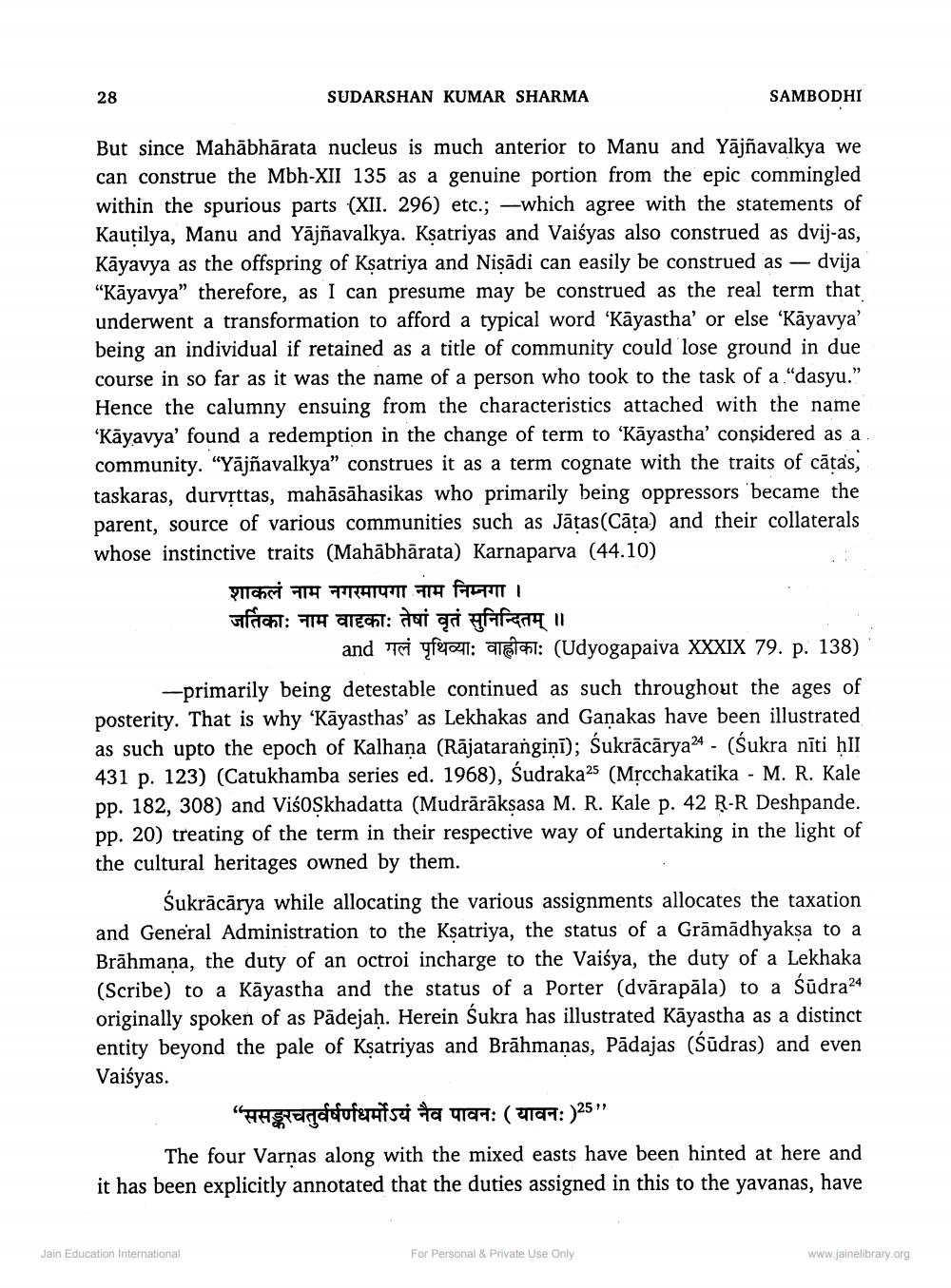________________
28
SUDARSHAN KUMAR SHARMA
But since Mahābhārata nucleus is much anterior to Manu and Yajnavalkya we can construe the Mbh-XII 135 as a genuine portion from the epic commingled within the spurious parts (XII. 296) etc.; -which agree with the statements of Kautilya, Manu and Yājñavalkya. Kṣatriyas and Vaisyas also construed as dvij-as, Kāyavya as the offspring of Ksatriya and Niṣādi can easily be construed as - dvija "Kayavya" therefore, as I can presume may be construed as the real term that underwent a transformation to afford a typical word 'Kayastha' or else 'Kayavya' being an individual if retained as a title of community could lose ground in due course in so far as it was the name of a person who took to the task of a "dasyu." Hence the calumny ensuing from the characteristics attached with the name. 'Kayavya' found a redemption in the change of term to 'Kayastha' considered as a community. "Yājñavalkya" construes it as a term cognate with the traits of catas, taskaras, durvṛttas, mahāsāhasikas who primarily being oppressors became the parent, source of various communities such as Jāṭas (Caṭa) and their collaterals whose instinctive traits (Mahabharata) Karnaparva (44.10)
शाकलं नाम नगरमापगा नाम निम्नगा । जर्तिकाः नाम वाहकाः तेषां वृतं सुनिन्दितम् ॥
Jain Education International
SAMBODHI
and गलं पृथिव्याः वाह्लीका: (Udyogapaiva XXXIX 79. p. 138)
-primarily being detestable continued as such throughout the ages of posterity. That is why 'Kayasthas' as Lekhakas and Ganakas have been illustrated as such upto the epoch of Kalhana (Rājatarangiṇī); Śukrācārya24 - (Śukra niti ḥII 431 p. 123) (Catukhamba series ed. 1968), Śudraka25 (Mṛcchakatika - M. R. Kale pp. 182, 308) and ViśOṢkhadatta (Mudrārākṣasa M. R. Kale p. 42 R-R Deshpande. pp. 20) treating of the term in their respective way of undertaking in the light of the cultural heritages owned by them.
Śukrācārya while allocating the various assignments allocates the taxation and General Administration to the Kṣatriya, the status of a Grāmādhyakṣa to a Brāhmaṇa, the duty of an octroi incharge to the Vaiśya, the duty of a Lekhaka (Scribe) to a Kayastha and the status of a Porter (dvārapāla) to a Śūdra24 originally spoken of as Padejaḥ. Herein Sukra has illustrated Kayastha as a distinct entity beyond the pale of Ksatriyas and Brahmanas, Pādajas (Śūdras) and even Vaiśyas.
""
“ससङ्करचतुर्वर्षर्णधर्मोऽयं नैव पावनः ( यावनः ) 25
The four Varnas along with the mixed easts have been hinted at here and it has been explicitly annotated that the duties assigned in this to the yavanas, have
For Personal & Private Use Only
www.jainelibrary.org




